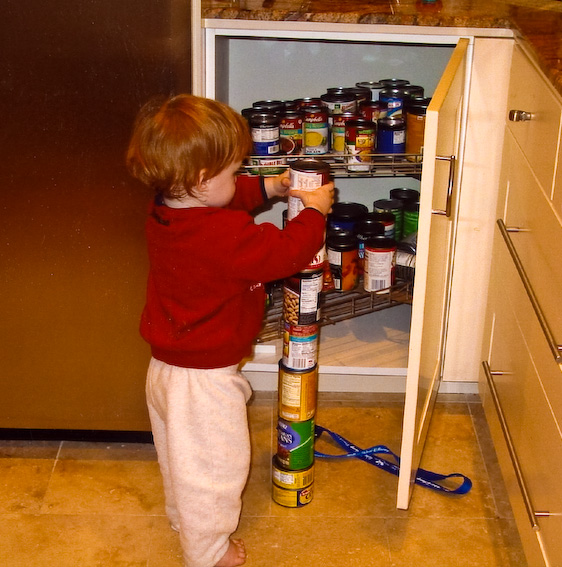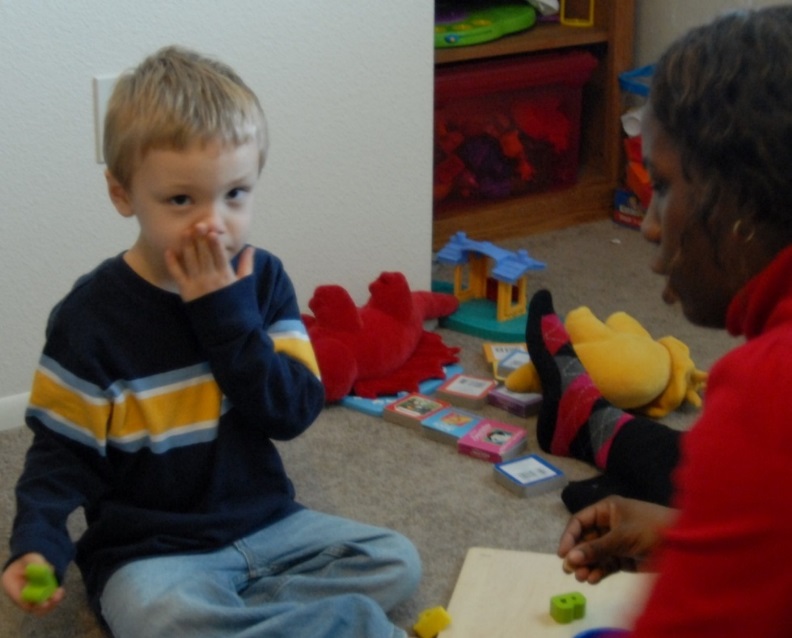Early Childhood Education
Learning Objectives
Type your learning objectives here.
- Discuss how early child education supports development and how our understanding of development influence education.
- Describe autism spectrum disorder, including characteristics and possible interventions.
Early Childhood Education
Providing universal preschool has become an important lobbying point for federal, state, and local leaders throughout our country. In his 2013 State of the Union address, President Obama called upon congress to provide high quality preschool for all children. He continued to support universal preschool in his legislative agenda, and in December 2014 the President convened state and local policymakers for the White House Summit on Early Education (White House Press Secretary, 2014).
However, universal preschool covering all four-year olds in the country would require significant funding. Further, how effective preschools are in preparing children for elementary school, and what constitutes high quality early childhood education have been debated.
To set criteria for designation as a high quality preschool, the National Association for the Education of Young Children (NAEYC) identifies 10 standards (NAEYC, 2016). These include:
- Positive relationships among all children and adults are promoted.
- A curriculum that supports learning and development in social, emotional, physical, language, and cognitive areas.
- Teaching approaches that are developmentally, culturally and linguistically appropriate.
- Assessment of children’s progress to provide information on learning and development.
- The health and nutrition of children are promoted, while they are protected from illness and injury.
- Teachers possess the educational qualifications, knowledge, and commitment to promote children’s learning.
- Collaborative relationships with families are established and maintained.
- Relationships with agencies and institutions in the children’s communities are established to support the program’s goals.
- The indoor and outdoor physical environments are safe and well-maintained.
- Leadership and management personnel are well qualified, effective, and maintain licensure status with the applicable state agency.
Parents should review preschool programs using the NAEYC criteria as a guide and template for asking questions that will assist them in choosing the best program for their child.

Figure 8.15 – Children making crafts at preschool.25
Selecting the right preschool is also difficult because there are so many types of preschools available. Zachry (2013) identified Montessori, Waldorf, Reggio Emilia, High Scope, Creative Curriculum and Bank Street as types of early childhood education programs that focus on children learning through discovery. Teachers act as facilitators of children’s learning and development and create activities based on the child’s developmental level. Here is a table summarizes characteristics of each type of program.
Table 8.3 – Types of Early Childhood Education Programs26
|
Program |
Founder |
Characteristics |
|
Montessori |
Dr. Maria Montessori |
|
|
Waldorf |
Rudolf Steiner |
|
|
Reggio Emilia |
Loris Malaguzzi |
|
|
High Scope |
David Weikart |
|
|
Bank Street |
Lucy Sprague Mitchell |
|
|
Creative Curriculum |
Diane Trister Dodge |
|
Head Start
For children who live in poverty, Head Start has been providing preschool education since 1965 when it was begun by President Lyndon Johnson as part of his war on poverty. It currently serves nearly one million children and annually costs approximately 7.5 billion dollars (United States Department of Health and Human Services, 2015). However, concerns about the effectiveness of Head Start have been ongoing since the program began. Armor (2015) reviewed existing research on Head Start and found there were no lasting gains, and the average child in Head Start had not learned more than children who did not receive preschool education.

Figure 8.16 – A photograph from when Head Start began.27
A recent report dated July 2015 evaluating the effectiveness of Head Start comes from the What Works Clearinghouse. The What Works Clearinghouse identifies research that provides reliable evidence of the effectiveness of programs and practices in education, and is managed by the Institute of Education Services for the United States Department of Education. After reviewing 90 studies on the effectiveness of Head Start, only one study was deemed scientifically acceptable and this study showed disappointing results (Barshay, 2015). This study showed that 3- and 4-year-old children in Head Start received “potentially positive effects” on general reading achievement, but no noticeable effects on math achievement and social-emotional development.
Nonexperimental designs are a significant problem in determining the effectiveness of Head Start programs because a control group is needed to show group differences that would demonstrate educational benefits. Because of ethical reasons, low income children are usually provided with some type of pre-school programming in an alternative setting. Additionally, Head Start programs are different depending on the location, and these differences include the length of the day or qualification of the teachers. Lastly, testing young children is difficult and strongly dependent on their language skills and comfort level with an evaluator (Barshay, 2015).28
Applications to Early Education
Understanding how children think and learn has proven useful for improving education. Activities like playing games that involve working with numbers and spatial relationships can give young children a developmental advantage over peers who have less exposure to the same concepts.
Mathematics
Even before they enter kindergarten, the mathematical knowledge of children from low-income backgrounds lags far behind that of children from more affluent backgrounds. Ramani and Siegler (2008) hypothesized that this difference is due to the children in middle- and upper-income families engaging more frequently in numerical activities, for example playing numerical board games such as Chutes and Ladders. Chutes and Ladders is a game with a number in each square; children start at the number one and spin a spinner or throw a dice to determine how far to move their token. Playing this game seemed likely to teach children about numbers, because in it, larger numbers are associated with greater values on a variety of dimensions. In particular, the higher the number that a child’s token reaches, the greater the distance the token will have traveled from the starting point, the greater the number of physical movements the child will have made in moving the token from one square to another, the greater the number of number-words the child will have said and heard, and the more time will have passed since the beginning of the game. These spatial, kinesthetic, verbal, and time-based cues provide a broad-based, multisensory foundation for knowledge of numerical magnitudes (the sizes of numbers), a type of knowledge that is closely related to mathematics achievement test scores (Booth & Siegler, 2006).
Playing this numerical board game for roughly 1 hour, distributed over a 2-week period, improved low-income children’s knowledge of numerical magnitudes, ability to read printed numbers, and skill at learning novel arithmetic problems. The gains lasted for months after the game-playing experience (Ramani & Siegler, 2008; Siegler & Ramani, 2009). An advantage of this type of educational intervention is that it has minimal if any cost—a parent could just draw a game on a piece of paper.
Reading
Cognitive developmental research has shown that phonemic awareness—that is, awareness of the component sounds within words—is a crucial skill in learning to read. To measure awareness of the component sounds within words, researchers ask children to decide whether two words rhyme, to decide whether the words start with the same sound, to identify the component sounds within words, and to indicate what would be left if a given sound were removed from a word. Kindergartners’ performance on these tasks is the strongest predictor of reading achievement in third and fourth grade, even stronger than IQ or social class background (Nation, 2008). Moreover, teaching these skills to randomly chosen 4- and 5-year-olds results in their being better readers years later (National Reading Panel, 2000).
Continuing Brain Maturation
Understanding of cognitive development is advancing on many different fronts. One exciting area is linking changes in brain activity to changes in children’s thinking (Nelson et al., 2006). Although many people believe that brain maturation is something that occurs before birth, the brain actually continues to change in large ways for many years thereafter. For example, a part of the brain called the prefrontal cortex, which is located at the front of the brain and is particularly involved with planning and flexible problem solving, continues to develop throughout adolescence (Blakemore & Choudhury, 2006). Such new research domains, as well as enduring issues such as nature and nurture, continuity and discontinuity, and how to apply cognitive development research to education, insure that cognitive development will continue to be an exciting area of research in the coming years.29
Cognitive Differences
Sometimes children’s brains work differently. One form of this neurodiversity is Autism spectrum disorder.
Autism: Defining Spectrum Disorder
Autism spectrum disorder (ASD) describes a range of conditions classified as neuro-developmental disorders in the fifth revision of the American Psychiatric Association’s Diagnostic and Statistical Manual of Mental Disorders (DSM-5). The DSM-5, published in 2013, redefined the autism spectrum to encompass the previous (DSM-IV-TR) diagnoses of autism, Asperger syndrome, pervasive developmental disorder not otherwise specified (PDD-NOS), and childhood disintegrative disorder. These disorders are characterized by social deficits and communication difficulties, repetitive behaviors and interests, sensory issues, and in some cases, cognitive delays.
Asperger syndrome was distinguished from autism in the earlier DSM-IV by the lack of delay or deviance in early language development. Additionally, individuals diagnosed with Asperger syndrome did not have significant cognitive delays. PDD-NOS was considered “subthreshold autism” and “atypical autism” because it was often characterized by milder symptoms of autism or symptoms in only one domain (such as social difficulties). In the DSM-5, both of these diagnoses have been subsumed into autism spectrum disorder.
Autism spectrum disorders are considered to be on a spectrum because each individual with ASD expresses the disorder uniquely and has varying degrees of functionality. Many have above-average intellectual abilities and excel in visual skills, music, math, and the arts, while others have significant disabilities and are unable to live independently. About 25 percent of individuals with ASD are nonverbal; however, they may learn to communicate using other means.
Social Communication Symptoms
Social impairments in children with autism can be characterized by a distinctive lack of intuition about others. Unusual social development becomes apparent early in childhood. Infants with ASD show less attention to social stimuli, smile and look at others less often, and respond less to their own name. Toddlers with ASD differ more strikingly from social norms; for example, they may show less eye contact and turn-taking and may not have the ability to use simple movements to express themselves. Individuals with severe forms of ASD do not develop enough natural speech to meet their daily communication needs.
Restricted and Repetitive Behaviors
Children with ASD may exhibit repetitive or restricted behavior, including:
- Stereotypy—repetitive movement, such as hand flapping, head rolling, or body rocking.
- Compulsive behavior—exhibiting intention to follow rules, such as arranging objects in stacks or lines.
- Sameness—resistance to change; for example, insisting that the furniture not be moved or sticking to an unvarying pattern of daily activities.
- Restricted behavior—limits in focus, interest, or activity, such as preoccupation with a single television program, toy, or game.
- Self-injury—movements that injure or can injure the person, such as eye poking, skin picking, hand biting, and head banging.

Figure 8.17 – A boy stacking cans.30
Etiology
While specific causes of ASD have yet to be found, many risk factors have been identified in the research literature that may contribute to its development. These risk factors include genetics, prenatal and perinatal factors, neuroanatomical abnormalities, and environmental factors. It is possible to identify general risk factors, but much more difficult to pinpoint specific factors.
Genetics
ASD affects information processing in the brain by altering how nerve cells and their synapses connect and organize; thus, it is categorized as a neuro-developmental disorder. The results of family and twin studies suggest that genetic factors play a role in the etiology of ASD and other pervasive developmental disorders. Studies have consistently found that the prevalence of ASD in siblings of children with ASD is approximately 15 to 30 times greater than the rate in the general population. In addition, research suggests that there is a much higher concordance rate among monozygotic (identical) twins compared to dizygotic (fraternal) twins. It appears that there is no single gene that can account for ASD; instead, there seem to be multiple genes involved, each of which is a risk factor for part of the autism syndrome through various groups. It is unclear whether ASD is explained more by rare mutations or by combinations of common genetic variants.
The Diversity of the Autism Spectrum
The rainbow-colored infinity symbol represents the diversity of the autism spectrum as well as the greater neurodiversity movement. The neurodiversity movement suggests that diverse neurological conditions appear as a result of normal variations in the human genome. It challenges the idea that such neurological differences are inherently pathological, instead asserting that differences should be recognized and respected as a social category on a par with gender, ethnicity, sexual orientation, or disability status.

Figure 8.18 – A symbol of the autism spectrum.31
Prenatal and Perinatal Factors
A number of prenatal and perinatal complications have been reported as possible risk factors for ASD. These risk factors include maternal gestational diabetes, maternal and paternal age over 30, bleeding after first trimester, use of prescription medication (such as valproate) during pregnancy, and meconium (the earliest stool of an infant) in the amniotic fluid. While research is not conclusive on the relation of these factors to ASD, each of these factors has been identified more frequently in children with ASD than in developing youth without ASD.
Environmental Factors
Evidence for environmental causes is anecdotal and has not been confirmed by reliable studies. In the last few decades, controversy surrounded the idea that vaccinations may be the cause for many cases of autism; however, these theories lack scientific evidence and are biologically implausible. Even still, parental concern about a potential vaccine link with autism has led to lower rates of childhood immunizations, outbreaks of previously controlled childhood diseases in some countries, and the preventable deaths of several children.
Treatment
There is no known cure for ASD, and treatment tends to focus on management of symptoms. The main goals when treating children with ASD are to lessen associated deficits and family distress and to increase quality of life and functional independence.32 Treatment for ASD should begin as soon as possible after diagnosis. Early treatment for ASD is important as proper care can reduce individuals’ difficulties while helping them learn new skills and make the most of their strengths.
The wide range of issues facing people with ASD means that there is no single best treatment for ASD.33 So treatment is typically tailored to the individual person’s needs. Intensive, sustained special-education programs and behavior therapy yearly in life can help children acquire self-care, social, and job skills. The most widely used therapy is applied behavior analysis (ABA); other available approaches include developmental models, structured teaching, speech and language therapy, social skills therapy, and occupational therapy.34

Figure 8.19 – A boy with ASD receiving therapy.35
There has been increasing attention to the development of evidenced-based interventions for young children with ASD. Although evidence-based interventions for children with ASD vary in their methods, many adopt a psychoeducational approach to enhancing cognitive, communication, and social skills while minimizing behaviors that are thought to be problematic.36
Conclusion
In this chapter we covered,
- Piaget’s preoperational stage.
- Vygotsky’s sociocultural theory.
- Information processing.
- How young children understand the world.
- Typical progression of cognitive and language development (milestones).
- Early childhood education.
- Autism spectrum disorder.
In the next chapter, we will finish covering early childhood education by looking at how children understand themselves and interact with the world.
